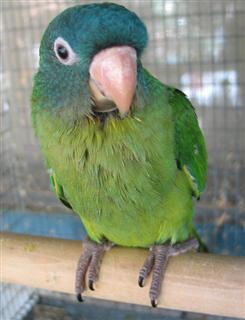Conure - Blue Crowned
Sharp Tailed Conure Scientific Name: Aratinga acuticaudata haemorrhous
Wed, 26th February, 2025 - 6:38 am GMT
Sponsor Ads:

Alternative Name
Sharp Tailed Conure Scientific Name: Aratinga acuticaudata haemorrhousBasic Info
Blue-crowned Conures are quite large, generally growing to about fourteen and a half inches. Their wingspans are generally around seven and a half inches. Although the birds are primarily green, the crowns of their heads are blue as their name makes clear! There are two shades of blue on a Blue-crowned Conure's head: a bright, darker blue and light, sky blue tinged shade. Their green bodies offer a variety of green shades all on the same bird! They do have the white eyepatch typical of Conures and the bills of Blue-crowned Conures are usually bi-colored. The top mandible is horn colored and the bottom mandible is usually colored black. The Conures wih bi-colored bills are often called Sharp-Tailed Conures. The underside of a Blue-crowned Conure's tail is a variegated shade of red, ranging from pink-red to dark rust. This species is sexually dimorphic, male Blue-crowned Conures have larger white eyepatches than do females, and the feathers of their ceres tend to be longer.
Health
Blue Crowned Conures should be fed a varied diet, which includes either a high formulated diet or a high quality seed mix supplemented with plenty of fresh fruits and vegetables like papaya, banana, beans, berries, peanuts, grapes, apples, peas and corn! Most Blue-crowned Conures appreciate a nesting box inside their cage so that they can hide when they are feeling stressed and so that they can have a quiet, private sleeping room! Like all parrots they should be given plenty of toys to prevent boredom.Habitat
They like open woods and low bush territories and are nomadic.Behavior
The Blue-crowned Conure is a favorite among many conure lovers. These lovely birds are affectionate, smart, playful and a joy to be around. Blue-crowned Conures live in large flocks in the wild. Often they are found associating with Mitred Conures. Blue-crowned Conures will, on occasion, eat farmers' crops! In captivity, you should feed your Blue-crowned Conure a varied diet so it doesn't get bored! Blue-crowned Conures are intelligent, social creatures who can be taught to talk! They are a little noisy and can screech at loud volumes, but are quieter and more laid-back than most Conures. Blue-crowned Conures love exercise and playtime, and also love cuddling with their keepers! They are escape artists and closely bonding friends, and are thought to be the most intelligent of the Conures! Blue-crowned Conures are renowned for their gentle, affectionate natures.Origin
BrazilHistory
Blue-crowned Conures are native to southwestern Brazil, northwestern Argentina, and most parts of Venezuela, Columbia, Paraguay and Uruguay. They prefer open woodlands and low bush lands, often near agricultural areas. They are not now threatened, but their habitat is quickly disappearing. Quite popular among Conure fanciers, Blue-Crowned Conures are more inexpensive than many birds, varying from 300 to 400 dollars. The species was first officially recorded by Viellot in 1818 and later a subspecies was recognized by Spix in 1824. In German, Blue-crowned Conures are known as Blaustirnsittich.Common Foods
They generally feed on the seeds and blossoms of ceibo trees but also eat mangoes and cacti.Sponsor Ads:
Thoughts on Programming, Number 11: 'Programming' - like 'loving' - is a single word that encompasses an infinitude of activities. -The Psychology of Computer Programming, Gerald M. Weinberg
Conure - Blue Crowned
Coded by: BGID® | ALL RIGHTS RESERVED Copyright © 2000-2025
Disclaimer | Privacy | Report Errors / Contact | Credits
















